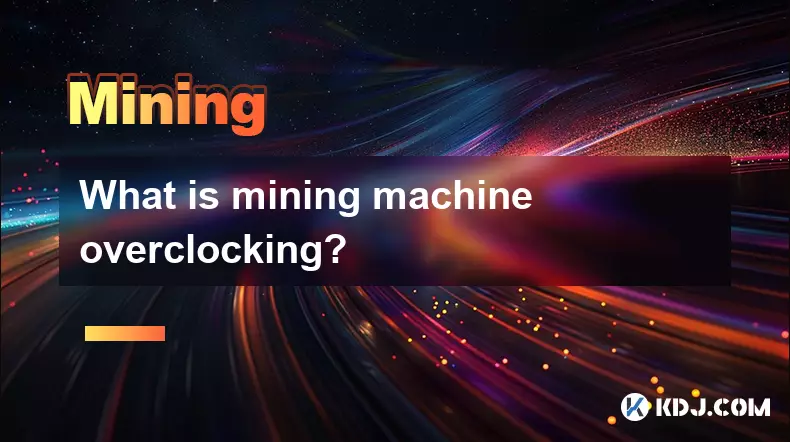-
 bitcoin
bitcoin $114779.865156 USD
2.30% -
 ethereum
ethereum $4226.519789 USD
2.39% -
 tether
tether $1.000545 USD
0.04% -
 xrp
xrp $2.890223 USD
0.92% -
 bnb
bnb $1030.029301 USD
2.95% -
 solana
solana $212.824944 USD
1.69% -
 usd-coin
usd-coin $0.999757 USD
0.01% -
 dogecoin
dogecoin $0.234961 USD
-0.27% -
 tron
tron $0.337174 USD
0.42% -
 cardano
cardano $0.804783 USD
0.09% -
 hyperliquid
hyperliquid $45.748770 USD
-2.85% -
 chainlink
chainlink $21.699170 USD
0.82% -
 ethena-usde
ethena-usde $1.001452 USD
0.08% -
 avalanche
avalanche $30.237800 USD
1.14% -
 stellar
stellar $0.372604 USD
1.52%
GPU vs. ASIC mining: which is better?
GPUs offer mining flexibility and resale value, while ASICs provide superior speed and efficiency for specific coins but lack adaptability.
Sep 07, 2025 at 10:36 am

GPU vs. ASIC Mining: Key Differences
1. Graphics Processing Units (GPUs) are versatile hardware components originally designed for rendering images and videos. Their parallel processing capability makes them effective for solving complex cryptographic algorithms used in cryptocurrency mining. Miners can use GPUs to mine various coins such as Ethereum, Ravencoin, and Dogecoin, especially those that rely on memory-hard algorithms like Ethash.
2. Application-Specific Integrated Circuits (ASICs), on the other hand, are built for one singular purpose—mining a specific cryptocurrency. For example, an ASIC designed for Bitcoin uses the SHA-256 algorithm and cannot mine coins that require different hashing methods. This specialization gives ASICs a massive advantage in both speed and energy efficiency when mining compatible coins.
3. One major distinction lies in accessibility. GPUs are widely available and can be purchased from consumer electronics retailers. ASICs are typically sold directly by manufacturers or through specialized distributors, often in bulk, making them less accessible to casual miners.
4. Upgradability is another factor. GPU miners can switch between different cryptocurrencies by simply changing mining software. ASIC users are locked into the algorithm their device supports, limiting flexibility unless they invest in additional hardware.
5. The initial cost of entry differs significantly. While high-end GPUs can be expensive, a full ASIC rig usually demands a much higher upfront investment. However, due to their superior hashrate, ASICs often achieve faster return on investment under optimal conditions.
Performance and Efficiency Comparison
1. In terms of raw performance, ASICs outperform GPUs by several orders of magnitude. A single modern ASIC can deliver hashrates exceeding 100 TH/s for Bitcoin, whereas even the most powerful GPU might reach only 100 MH/s when mining Ethereum—demonstrating a performance gap of over 1,000 times.
2. Energy efficiency is a critical metric in mining profitability. ASICs are engineered to maximize hash output per watt consumed. Top-tier ASIC models achieve efficiencies below 30 joules per terahash (J/TH), while high-end GPUs typically operate at around 150-200 joules per gigahash (J/GH), which translates to significantly higher power costs over time.
3. Heat generation correlates directly with power consumption. ASICs, despite their efficiency, produce concentrated heat due to their compact design and high operational intensity. Proper ventilation and cooling infrastructure are essential. GPUs, while less efficient, distribute heat across larger surface areas and are easier to manage in smaller setups.
4. Noise levels are often overlooked but important, especially in residential environments. ASICs tend to be much louder due to powerful internal fans required to cool dense circuitry. GPU rigs can also be noisy, but individual fans are generally quieter and more adjustable.
5. Long-term operational costs heavily favor ASICs when mining compatible coins, provided electricity rates are low and cooling is adequately managed. However, this advantage diminishes if the target cryptocurrency changes its consensus mechanism or becomes dominated by even more advanced ASIC models.
Economic and Market Considerations
1. The resale value of mining equipment fluctuates with market conditions. GPUs retain broader utility beyond mining, including gaming, video editing, and machine learning, which supports residual demand. ASICs, being single-purpose devices, often lose most of their value once they become obsolete or the target coin’s profitability drops.
2. Market saturation plays a role in profitability. As more miners deploy ASICs for popular coins like Bitcoin, the network difficulty increases, reducing individual rewards. This creates a competitive environment where only large-scale, low-cost operations remain profitable.
3. Regulatory scrutiny is growing around energy-intensive mining activities. Jurisdictions imposing restrictions on power usage may disproportionately affect ASIC farms due to their high total consumption, even if per-unit efficiency is better.
4. Cryptocurrency protocol changes can render ASICs useless overnight. For example, Ethereum’s shift from Proof-of-Work to Proof-of-Stake made all Ethereum-mining ASICs and GPUs dedicated to Ethash obsolete for that purpose. This risk is absent for GPU miners who can pivot to other coins quickly.
5. Investment strategy varies between the two. GPU mining suits those seeking flexibility and moderate entry points, while ASIC mining appeals to operators focused on maximizing output for specific, stable networks like Bitcoin.
Frequently Asked Questions
Can I use an ASIC to mine Ethereum? No. Ethereum uses the Ethash algorithm, which is resistant to ASIC optimization. Furthermore, Ethereum has transitioned to a Proof-of-Stake model, eliminating mining altogether. Any ASIC built for Ethash is now limited to alternative coins using the same algorithm.
Are GPUs still profitable for mining in 2024? Yes, but only under specific conditions. Profitability depends on local electricity costs, the choice of mineable coin, and hardware efficiency. Coins like Raven (RVN) or Ergo (ERG) remain viable for GPU mining, especially with mid-to-high-end cards running at low power rates.
Do ASIC miners require special power supplies? Yes. Most ASIC miners operate at high power draws and often require dedicated 240V circuits. Standard ATX power supplies used in PCs are insufficient. Manufacturers typically recommend industrial-grade power supplies or direct grid connections for stable operation.
Is home mining with GPUs still feasible? It can be, though margins are tight. Success depends on access to cheap electricity, efficient cooling, and selecting coins with favorable reward-to-difficulty ratios. Many home miners treat it as a side activity rather than a primary income source due to fluctuating returns.
Disclaimer:info@kdj.com
The information provided is not trading advice. kdj.com does not assume any responsibility for any investments made based on the information provided in this article. Cryptocurrencies are highly volatile and it is highly recommended that you invest with caution after thorough research!
If you believe that the content used on this website infringes your copyright, please contact us immediately (info@kdj.com) and we will delete it promptly.
- Government Shutdown, Trump Meeting, Deadlock: A New Yorker's Crypto Take
- 2025-09-30 10:45:12
- Token Securities, Stablecoins, and Synergy: A New Standard for Digital Finance in NYC
- 2025-09-30 10:25:15
- Dogecoin, Shiba Inu, and Remittix: Decoding the Crypto Hype
- 2025-09-30 10:25:15
- Bitcoin Surge: Bullish Factors and Seasonal Trends Fueling the Rally
- 2025-09-30 10:45:12
- Binance Coin Breakout: Riding the Cryptocurrency Wave
- 2025-09-30 10:50:01
- Bitcoin, Corporate Treasury, and Fintech Startups: A New Era of Finance
- 2025-09-30 10:50:01
Related knowledge

The difference between staking and mining
Sep 24,2025 at 05:18am
Understanding Staking in the Cryptocurrency Ecosystem1. Staking involves holding funds in a cryptocurrency wallet to support the operations of a block...

How to participate in testnet mining?
Sep 22,2025 at 09:18am
Understanding Testnet Mining in the Crypto Ecosystem1. Testnet mining is a method used by blockchain developers to simulate real-world conditions on a...

How to dispose of abandoned mining machines?
Sep 19,2025 at 08:19pm
Assessing the Condition of Abandoned Mining Rigs1. Begin by inspecting each mining machine for visible damage, corrosion, or missing components. Machi...

How to identify high-quality mining pools?
Sep 21,2025 at 03:19pm
Reputation and Track Record1. A mining pool’s reputation is built over time through consistent performance and transparency. Pools that have operated ...

Advantages of decentralized mining pools
Sep 20,2025 at 04:36pm
Enhanced Security and Resistance to Censorship1. Decentralized mining pools operate on blockchain-based smart contracts, eliminating the need for a ce...

What is mining machine overclocking?
Sep 21,2025 at 07:19pm
Understanding Mining Machine Overclocking1. Mining machine overclocking refers to the process of increasing the operating frequency of a cryptocurrenc...

The difference between staking and mining
Sep 24,2025 at 05:18am
Understanding Staking in the Cryptocurrency Ecosystem1. Staking involves holding funds in a cryptocurrency wallet to support the operations of a block...

How to participate in testnet mining?
Sep 22,2025 at 09:18am
Understanding Testnet Mining in the Crypto Ecosystem1. Testnet mining is a method used by blockchain developers to simulate real-world conditions on a...

How to dispose of abandoned mining machines?
Sep 19,2025 at 08:19pm
Assessing the Condition of Abandoned Mining Rigs1. Begin by inspecting each mining machine for visible damage, corrosion, or missing components. Machi...

How to identify high-quality mining pools?
Sep 21,2025 at 03:19pm
Reputation and Track Record1. A mining pool’s reputation is built over time through consistent performance and transparency. Pools that have operated ...

Advantages of decentralized mining pools
Sep 20,2025 at 04:36pm
Enhanced Security and Resistance to Censorship1. Decentralized mining pools operate on blockchain-based smart contracts, eliminating the need for a ce...

What is mining machine overclocking?
Sep 21,2025 at 07:19pm
Understanding Mining Machine Overclocking1. Mining machine overclocking refers to the process of increasing the operating frequency of a cryptocurrenc...
See all articles










































































